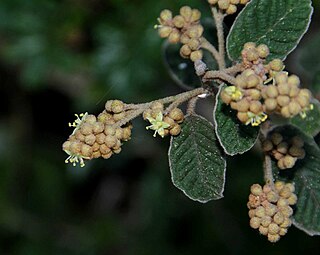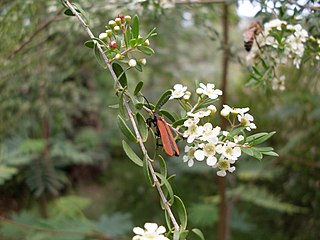
Cupaniopsis newmanii, commonly known as long-leaved tuckeroo, is a species of flowering tree in the soapberry family and is endemic to eastern Australia. It is a rainforest tree with paripinnate leaves with 16 to 24 narrowly egg-shaped to elliptic leaflets, and separate male and female flowers arranged in panicles, the fruit a rust-coloured capsule flushed with pink.

Swainsona greyana, commonly known as the Darling pea or hairy-Darling pea, is a species of flowering plant in the family Fabaceae and is endemic to south-eastern continental Australia. It is an erect perennial subshrub with imparipinnate leaves with 17 to 21 egg-shaped leaflets, and racemes of 12 to 20 or more white, pink or purple flowers.

Swainsona behriana, commonly known as Behr's swainsona, is a species of flowering plant in the family Fabaceae and is endemic to south-eastern continental Australia. It is a prostrate or low-growing perennial herb with imparipinnate leaves usually with 9 to 13 narrowly elliptic to egg-shaped leaflets with the narrower end towards the base, and racemes of 2 to 7 purple flowers.

Pomaderris oraria, commonly known as Bassian dogwood, is a species of flowering plant in the family Rhamnaceae and is endemic to south-eastern Australia. It is a compact shrub with hairy branchlets, hairy, elliptic leaves and panicles of hairy, greenish to cream-coloured or crimson-tinged flowers.

Acronychia pubescens, commonly known as hairy acronychia or hairy aspen, is a species of tall shrub or small tree that is endemic to eastern Australia. It usually has trifoliate leaves, rarely simple leaves, groups of whitish flowers in leaf axils and creamy to yellowish, elliptical to spherical fruit.

Gaudium jingera, commonly known as the stringybark tea-tree, is a species of shrub that is endemic to Victoria, Australia. It has papery bark on the larger branches, smooth bark on the younger stems, narrow egg-shaped to elliptical leaves, white flowers and silky-hairy, hemispherical fruit.

Sannantha pluriflora, commonly known as tall baeckea, is a species of flowering plant in the myrtle family, Myrtaceae, and is endemic to continental southeastern Australia. It is a shrub or small tree with lance-shaped to elliptic leaves, and groups of two to nine white flowers arranged in umbels in leaf axils.

Pultenaea blakelyi, commonly known as Blakely's bush-pea, is a species of flowering plant in the family Fabaceae and is endemic to south-eastern continental Australia. It is an erect shrub with sharply-pointed, narrow elliptic to egg-shaped leaves and yellow to orange flowers in open clusters in leaf axils or at the ends of branches.
Bossiaea distichoclada is a species of flowering plant in the family Fabaceae and is endemic to south-eastern continental Australia. It is an erect shrub with hairy branches, kidney-shaped to more or less round or heart-shaped leaves with the narrower end towards the base, and uniformly bright yellow flowers.

Dodonaea subglandulifera, commonly known as Peep Hill hop-bush, is a species of plant in the family Sapindaceae and is endemic to South Australia. It is a small, upright shrub with flowers in small groups that are yellow-greenish to red-maroon.

Swainsona brachycarpa, commonly known as slender swainson-pea, is a species of flowering plant in the family Fabaceae and is endemic to eastern Australia. It is a prostrate or ascending perennial herb with imparipinnate leaves usually with 9 to 13 egg-shaped to narrowly elliptic or egg-shaped leaflets, and racemes of up to 12 white, purple or dark red flowers.
Swainsona complanata is a species of flowering plant in the family Fabaceae and is endemic to northern Western Australia. It is an erect, annual herb with imparipinnate leaves usually with up to 13 narrowly egg-shaped leaflets with the narrower end towards the base, and racemes of up to 20 mauve to maroon flowers.
Swainsona forrestii is a species of flowering plant in the family Fabaceae and is endemic to the central northern Western Australia. It is an erect or spreading, single-stemmed annual herb, with imparipinnate leaves with about 13 to 17 narrowly egg-shaped or narrowly ellipitic leaflets, and racemes of dark brownish red to purple or pink flowers in racemes of 30 or more.
Swainsona katjarra, commonly known as Birriliburu swainsona, is a species of flowering plant in the family Fabaceae and is endemic to inland Western Australia. It is an erect annual herb with imparipinnate leaves with 4 to 6 lance-shaped to egg-shaped to elliptical leaflets, and racemes of 15 to 25 magenta flowers.
Swainsona microcalyx, commonly known as wild violet, is a species of flowering plant in the family Fabaceae and is endemic to southern mainland Australia. It is a prostrate or low-growing perennial herb, with imparipinnate leaves with 5 to 9 broadly egg-shaped to wedge-shaped leaflets and racemes of 5 to 15 purple flowers.
Swainsona plagiotropis, commonly known as red swainsona-pea is a species of flowering plant in the family Fabaceae and is endemic to eastern continental Australia. It is a prostrate or ascending perennial herb with imparipinnate leaves with 13 to 25 narrowly egg-shaped or narrowly lance-shaped leaflets and racemes of 2 to 5 reddish-purple flowers.
Swainsona tanamiensis is a species of flowering plant in the family Fabaceae and is endemic to north-western Australia. It is a prostrate or erect perennial plant with imparipinnate leaves with 5 to 13 broadly egg-shaped to elliptic, or almost round leaflets, and racemes of up to 8 purple flowers.

Swainsona tenuis is a species of flowering plant in the family Fabaceae and is endemic to western continental Australia. It is a prostrate perennial herb with many stems, imparipinnate leaves with 5 to 9 egg-shaped leaflets with the narrower end towards the base, to linear or elliptic leaflets, and racemes of up to 7 purple flowers.

Swainsona tephrotricha is a species of flowering plant in the family Fabaceae and is endemic to eastern South Australia. It is an erect or ascending perennial plant, with imparipinnate leaves with 7 to 19 broadly egg-shaped to narrowly elliptic leaflets, and racemes of 30 or more pink or pinkish-purple flowers.

Dodonaea adenophora is a species of plant in the family Sapindaceae and is endemic to the south-west of Western Australia. It is an erect or spreading shrub with imparipinnate leaves, usually with four or six leaflets, single or paired flowers and capsules with four wings.














